CHAPTER THREE
Findings Basics
Most handcrafted wirework jewelry requires some type of finding to make it functional. Clasps keep necklaces and bracelets closed around the wearer’s neck or wrist. Earring findings are used to suspend earring elements from the ears, while earring backs secure earrings to the ear. Other types and styles of findings improve functionality and add decorative interest.
Clasp Findings
A myriad of styles of clasps is available. Simple clasps include lobster claws, spring rings, and toggles. More specialized closures include tube and bar clasps, box clasps, and multistrand clasps. Selecting the best clasp for your project is partly a matter of taste, partly about design, and partly application.
Barrel clasps are two-piece clasps that screw together. This style of clasp comes in a range of shapes, sizes, and finishes.
Box clasps are two-piece clasps that comprise a box and a small, pressure-fitted piece that snaps into the box. Some box clasps have tiny snap locks for extra security. This clasp is good for use with bracelets and necklaces. Box clasps come in lots of shapes, sizes, decorative designs, and metals from plated to precious.
J-hooks are shaped pieces of metal that connect with soldered rings or jump rings on either end. This clasp is best used on necklaces and comes in simple and decorative styles. J-hooks come in a range of sizes and in metals from plated to precious.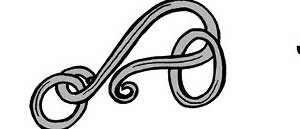
Lanyard clasps are thin, one-piece clasps shaped like a long drop with a flexible snap closure. This clasp is used mostly for identification lanyards or jewelry projects made of leather or hemp. Lanyard clasps are usually made from plated metals.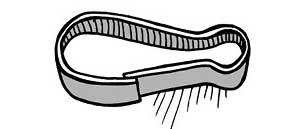
Lobster claws are a very popular and secure clasp, frequently used with flexible beading wire and crimp beads. They can be used with just about any finding and stringing material to finish a jewelry project. This clasp is shaped like a lobster claw and comes in a variety of sizes, designs, and metals from plated to precious.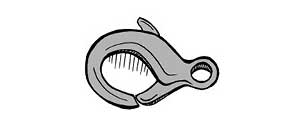
Magnetic clasps are two-part clasps held together by strong magnets. This type of clasp is good for lightweight jewelry and for people who have trouble opening lobster claws or spring rings. Magnetic clasps come in a wide range of magnetic strengths, sizes, and designs.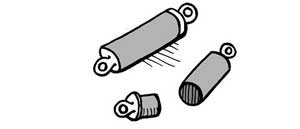
Pearl clasps are very traditional, oval-shaped clasps with filigree detail. This type of clasp has a unique hook and snap closure. Pearl clasps are traditionally made from precious metals but are now available in other metals as well.
S-hooks are shaped pieces of metal that connect with soldered rings or jump rings on either end. This clasp is best used on necklaces, and it comes in simple and decorative styles. S-hooks come in a small range of sizes and in metals from plated to precious.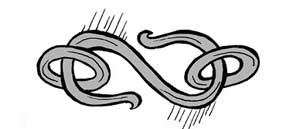
Spring rings are shaped like a ring with a spring-loaded barrel. This clasp is frequently used with flexible beading wire and crimp beads. A spring ring can also be used with just about any finding and string material to finish a jewelry project. These clasps come in a variety of sizes and metals from plated to precious.
Toggle clasps are made with two parts: a ring and a bar. The bar slides through the ring and then lies across it to close. This clasp is less secure than a lobster claw or spring ring but is often easier to use. Toggle clasps are made in a vast array of decorative designs and are often included as a design element in jewelry projects. These clasps come in a variety of sizes and metals from plated to precious.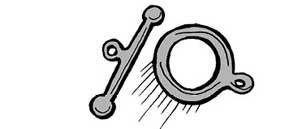
Tube and bar clasps typically have two parts that slide together and snap into place to form a tube with connection points on each side. These connection points are either bars that run the length of each side of the tube, or a series of two, three, five, or seven loops on each side of the tube. Some versions of these clasps are magnetic for added security. Tube and bar clasps are ideal for making multistrand necklaces or bracelets. They are available in plated and precious metals.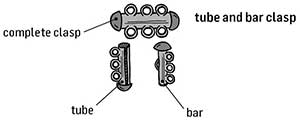
Earring Findings
Earring findings are made for both pierced and non-pierced ears in a wide range of styles, sizes, and materials. The most basic earring design is made from three components: an ear wire, a finding for attaching a decorative element to the ear wire, and a finding for securing the ear wire to the earlobe.
Shepherd’s hook ear wires date back to Roman times. They are shaped like a shepherd’s crook, consequently the name. This style of ear wire is similar to the fishhook/French wire but has a longer shaft.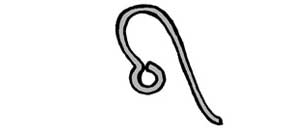
Fishhook/French wire ear wires are curved at the top and have a hook-shaped shaft that passes through the pierced ear. This type of ear wire comes in a variety of styles.
Add-a-bead is designed to add any bead and to finish with a loop.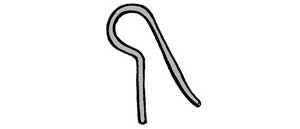
Post earrings, sometimes called stud with a loop, are a style of pierced earring that sits tight to the earlobe. A ball or decorative element is soldered to a stud that passes through the pierced ear. A loop from which the head pin hangs is then soldered to the front of the ball or decorative element. Post earrings come in a wide range of styles.
Kidney wires come in a variety of shapes and sizes. They are similar to the fishhook/French wire except they close for added security.
Lever backs are similar to fishhooks, but the hook actually snaps closed and has either a soldered or an unsoldered loop from which the head pin hangs.
Earring strings or earring threads are pieces of chain with a blunt pin that strings directly through the ear and a soldered loop from which the head pin hangs.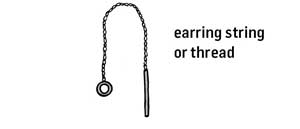
Hoops come in a variety of sizes. Jewelry makers can wire-wrap beads around the hoop, string beads directly onto the hoop, or hang them from the hoop.
Clip-ons come in a variety of styles for nonpierced ears. The most common style is a ball with a loop from which the head pin, bead, or charm hangs. Other styles use a decorative element in place of the ball or provide a flat pad for gluing.
Screw back with a loop is for non-pierced ears. The most common style is a ball with a loop from which the head pin, bead, or charm hangs. Other styles use a decorative element in place of the ball.
Eye pins are wire pins with a loop at the bottom for making earrings. They are also useful for making multisection earrings. Eye pins can be purchased ready-made or made by hand from a wide range of gauges and lengths.
Headpins are wire pins with a flat or decorative bottom for making earrings. Basic headpins have a flat bottom simply to keep beads from falling off of the pin. Decorative head pins come in many different styles. Headpins can be purchased ready-made or made by hand from a wide range of gauges and lengths.
Chandelier findings are a decorative wire or metal elements that can be purchased or made in a multitude of shapes, gauges, and metals. Jewelry makers wire-wrap these components with beads, suspend beads from them, or combine them with other materials to make sensational earrings.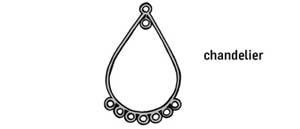
Earring Backs
Earring backs are an essential finding for securing earrings to the earlobe and to help prevent loss. They come in a variety of styles to both suits the wearer and match the earring.
Rubber earring backs slide onto the back of a fishhook and can be adjusted for tightness. The most common styles are made of either softer, white, spongy rubber or stiffer, clear plastic acrylic.
Ear nuts are small, metal components used to keep a post earring secured to the earlobe. They come in several different sizes and in a variety of metals to match the metals of post earrings.
Monster earring backs are dome-shaped ear nuts with a large, round, clear plastic disk attached to them. These backs are useful when wearing large or heavy post earrings. The plastic disk ensures that the earring fits snugly on the earlobe.
Other Findings
The addition of caps and cones is usually a decorative design choice. Caps are sometimes used to mask unsightly bead holes, and cones are often added to hide the ends of a multistrand project. Rings are used for practical reasons, most commonly to connect a wire to findings, to add decorative elements to the wire or chain, or as part of a closure.
Caps are decorative, half-sphere-shaped findings that fit over bead holes to disguise the opening or add to the design of the piece. They come in a complete range of designs, sizes, and metals from plated to precious.
Cones are decorative, conical-shaped findings. They are used to conceal multiple strands of beads that attach to a single clasp. They come in a complete range of designs, sizes, and metals from plated to precious.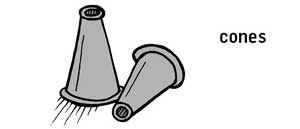
Rings are made in a variety of metals so they will match other metals in a project. Each type of ring comes in a wide range of sizes and wire gauges, and each type of ring has a specialized use.
Jump rings are open, unsoldered rings that can be used to attach clasps, pendants, charms, and other components together or to a chain. They come ready-made or can be made in a variety of gauges and sizes.
Soldered rings are closed rings that can be used with crimped flexible beading wire, wire-wrapped pieces, or bead tips. Soldered rings are the most secure ring choice.
Split rings are formed like small key rings. They are used to securely attach clasps and charms to a chain or other rings. Split ring pliers may be used for easy attachment.
You can read the previous entry in the series here. You can see the next entry in the series here.
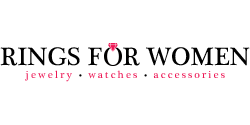
 Beaded Jewelry – Chapter Two
Beaded Jewelry – Chapter Two